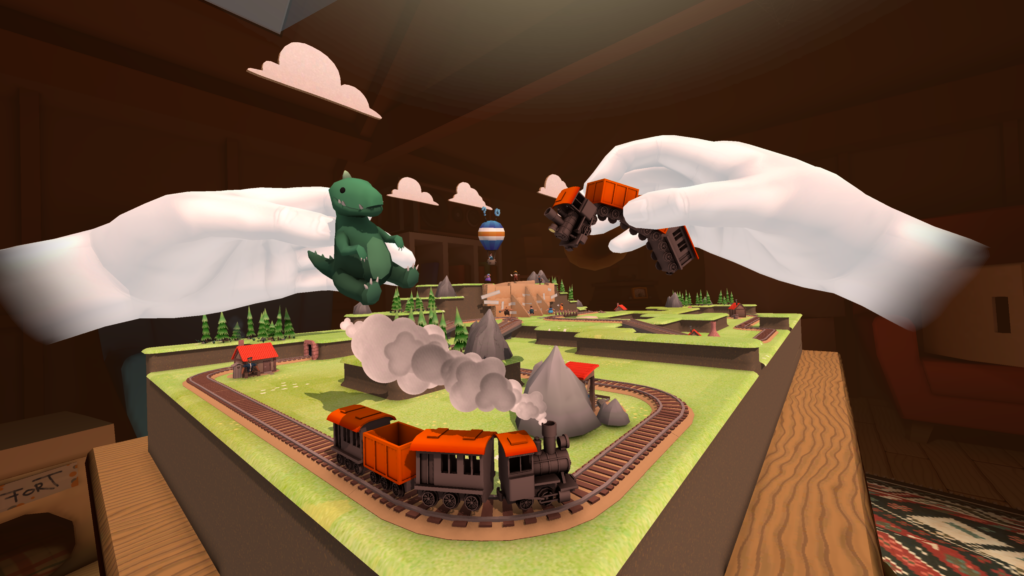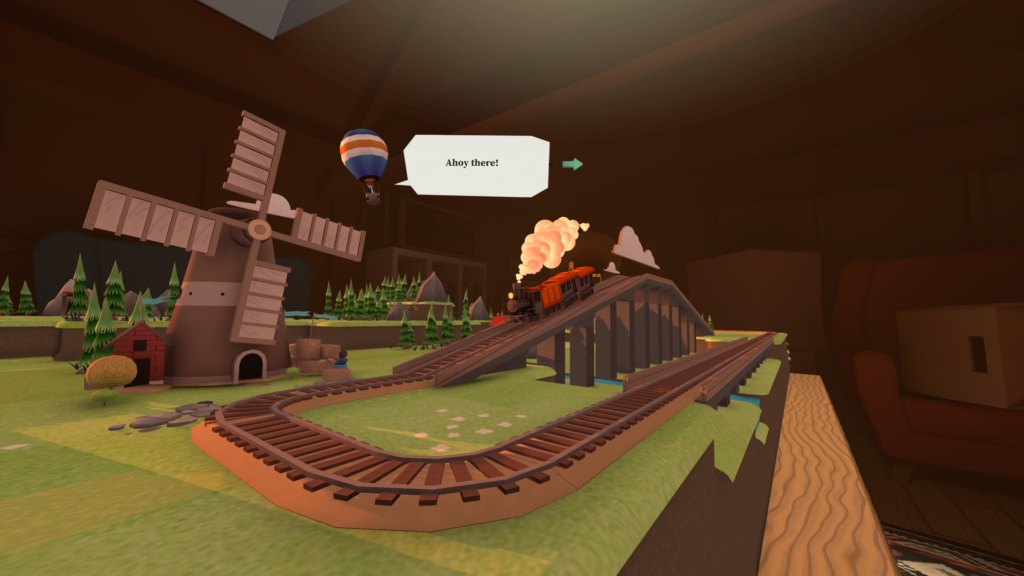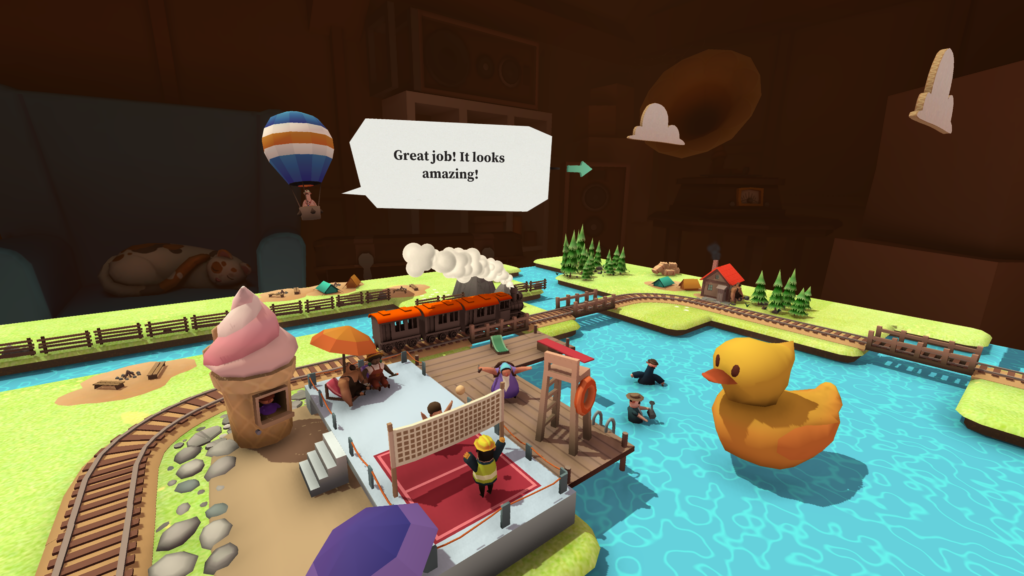In the enchanting realm of virtual reality, Toy Trains emerges as a testament to creativity and innovation. I am thrilled to present an exclusive interview with Marcin Jóźwik, the driving force behind this imaginative project at Something Random. The developers, with a background from the acclaimed SUPERHOT VR, bring a unique perspective to Toy Trains, a game that transcends the conventional boundaries of VR gaming.
This interview delves into the inspirations and challenges faced in the development of Toy Trains, exploring how a simple idea blossomed into a captivating VR experience. From its serene and creative gameplay to the intricate design of its miniature worlds, Marcin shares insights into the game’s evolution and its appeal to a diverse audience.
Whether you’re a VR enthusiast, a fan of innovative gaming, or just curious about the behind-the-scenes magic of game development, this conversation with Marcin Jóźwik is sure to enlighten and inspire. Join us as we journey through the imaginative world of Toy Trains and uncover the passion and creativity that drives the future of VR gaming. But first, check out the official trailer:
Could you start by telling us a bit about yourself, your role in the development of Toy Trains, and how you got involved in this project?
Hi! I’m Marcin Jóźwik, Project Lead of Toy Trains at Something Random.
I was lucky enough to be involved in Toy Trains development from the very beginning and was one of the first hires of the company, which was initially fully composed of the former SUPERHOT developers, including me.
In Toy Trains, I was responsible for the preproduction, the game design, production, coordinating the team and making prototypes of new features. We are a small team, so I had a chance to try different things along the way.
What was the main inspiration behind Toy Trains, and how did the concept evolve from the initial idea to the final game?
Cezary Skorupka, our CEO, came up with the idea for Toy Trains while playing with wooden tracks and trains with his son. They were building elaborate wooden railways, crazy loops, imagining new scenarios to play. However, their fun was cut short when they ran out of tracks. At that moment, a question emerged: “What if we could have the same experience in VR but with unlimited tracks?”
When we started working on the game, we initially took inspiration from games like Dorfromantik, Islanders, Build and Grow – all of them being logical games mechanically, but, at the same time, being about self-expression and relaxation thematically. Common characteristics that I think we managed to capture in Toy Trains as well.
The concept evolved with each iteration and was constantly moving on a spectrum between being a sandbox and being a puzzle game. In its final form the game offers, what we’ve called, open-ended challenges, a state of curated play. Every level introduces a new challenge, but there is a lot of freedom in the way of tackling the problems.
Having previously worked on SUPERHOT VR, what was it like transitioning from an action-packed game to the more serene and creative world of Toy Trains?
Many of us were tired of the existential drama of the SUPERHOT franchise. Themes of addiction, suicide, obsession. We wanted to take a break from that.
Since the core team worked at SUPERHOT, we also didn’t want to compete with it by making a shooter with a similar setting. We already know how to do it and we wanted to explore new areas that, I think, are yet to be discovered in VR.
Having said that, the design principles of SUPERHOT are also present in Toy Trains. It’s a game that puts you in action in the very first minutes, uses the medium of VR in a tactile and intuitive way and deals with the topic of stopping time – but this time seen from a very different angle.

Who do you see as the primary audience for Toy Trains? Was the game designed with a specific demographic in mind?
We didn’t have a specific target audience in mind. We just wanted to make a game that uses VR in the most accessible and natural way possible. A game that could be a place to chill, relax and feel smart. And if you are into that, you will be hooked by Toy Trains regardless of being 7 years old or 70 years old.
Can you share some insights into the creative process of designing the game’s miniature worlds and track-building mechanics?
The production of Toy Trains included a lot of time for experimenting – we really wanted to find mechanics that are fun, easy to learn and lead to interesting choices at the same time.
We wanted to give players just the right amount of freedom. Not too little to get frustrated in seeking “the one and only” solution intended by the designer, but also not too much to get lost and feel a lack of purpose when the initial excitement wears off.
We were also testing different mechanics that would work nicely with the theme such as accumulating resources in the real-time, gaining profit from efficient loops, buying items from the catalogue, batteries for managing what is turned on and off on the map, different kinds of trains and wagons with unique rulesets. We had all of that at some point or another – but we decided to drop it.
It turned out the engaging and rewarding core of the game was building loops. And people wanted to do that. Not think about management and economy. Those additional features might be closer to reality of trains, but were steering players away from what was fundamentally fun about Toy Trains.
In the end, one of the only resources that players have in the game is the free space on the map and the biggest enemy is the player himself. We found out pretty quickly that players are very reluctant to remove their own tracks. They make a sub-optimal move, stick with it and build a much more convoluted loop than necessary only not to remove anything. So surprisingly, giving players more space, also gave them more space for errors, leading to a more difficult challenge. A challenge, in which players are not blaming the game for difficulties, but rather themselves.
Could you delve a bit into the storyline and themes of Toy Trains? How do they enhance the player’s experience?
In the very first pitch of the game there was a line on the top of the page: a game about connections. And I think the same line could be there today as we are releasing Toy Trains. On the mechanical level, it’s simple – you’re connecting tracks and connecting objects on the map together.
But we wanted to push it further and we were searching for themes that could resemble that theme on the narrative level. So, in the tiny world of Toy Trains you’re helping Railies (those little guys) sitting lonely in their houses to connect with each other. In the world of the attic, we are exploring the connection and distance between parents and their child.
When the mechanics and the narrative speak the same language, the player will feel that the game is complete, coherent, immersive. Even if that player cannot really say why.
What were some of the biggest challenges you faced during the development of Toy Trains, and how did you overcome them?
It’s the first title produced by our company, so we were assembling the team, figuring out our way of working alongside actual making of the game. So you could say that we not only went through the whole prototype-preproduction-production phase of the game, but also of the whole company! But this release gave us the confidence that we are capable of creating high-quality games and I cannot wait what the future will bring!
For me personally, the biggest challenge was to reconcile the role of the designer with the role of the producer. I often felt like there were two voices in my head, giving me contradictory advice. The designer wanted the best experience of all, the producer wanted to mitigate the risk and meet the deadlines. What helped me a lot was to actually say to the team that “right now, I’m speaking as a designer” or “right now, I’m speaking as a producer” giving them (and me!) the context of my decisions.

The art style of Toy Trains is unique and visually appealing. What influenced the artistic direction of the game?
We wanted an art style that would stand the test of time. Our art director Martyn Gill believes that if something looks “fresh” or “exciting” after several decades it is a sign that the graphic design was solid from the very beginning. The greatest success for us will be if someone plays this game in 15 years and says it looks great. And with this philosophy, inspirations were drawn from the works that are quite dated but they keep their charm.
The influence came from different sources. The aesthetics of the catalogue took inspiration from post-war American train set brochures, the tiny world of Toy Trains is heavily influenced by aesthetics of UPA’s animations and you could even find references to old soviet matchbox art and old offset printing.
As a principle, we wanted the game to look universal, cute, pure and almost innocent but also being rooted in a realism at the same time. We wanted to create a magical place for the player, but without sacrificing the realism of the objects around you. So almost every item you encounter in the game could work and look similar in the real world: the game box, the catalogue, the hot air balloon, the toys, the tracks, the houses, you name it.
I think this principle really contributes to the feeling of nostalgia, immersion, the state of being a child that people experience while playing Toy Trains.
How important was the sound design and music in creating the atmosphere of Toy Trains, and what was your approach to it?
The sound design and music came pretty late in the production, in the time when the art style, mechanics and story of the game were pretty much set in stone. Both Kostek (our sound designer) and BT Loops (our composers) did a terrific job that put this project on another level. Sound is one of those things that you may not see when it’s done well but has a tremendous effect on the overall experience on the unconscious level.
At first, the audio team worked rather independently and I haven’t heard the progress for a while. Then, when I first launched Toy Trains with background music and the three-dimensional ambient I almost cried. It all worked so well together. I thought to myself: “This is it. This is Toy Trains.”
Are there any future updates or expansions planned for Toy Trains? What can players look forward to?
Basically, it is all in players’ hands now! With a good reception and people buying enough copies, we will definitely want to explore the idea further, because there are lots of topics that we didn’t even touch on and would potentially be a great addition to the game. The sandbox mode, new tracks and levels, mixed reality support, sharing and cooperation – we have plans for all of that if players support us on this journey.
From your perspective, how do you see VR gaming evolving in the next few years, and what role do you think games like Toy Trains will play in this evolution?
I hope the VR industry will find its identity and deliver games and apps that make real use of the possibilities of this new fascinating medium. With lighter and more convenient devices, the evolution of hand tracking and embedded mixed reality, I hope that the gap between VR hardcore users and ordinary people will start to shrink. For many, VR is still this sci-fi alien technology that detaches you from the world outside and that genuinely ****scares people.
Having said that, I think Toy Trains, with its intuitive design and being as challenging as you allow it to be, could be a great introduction to VR and even to games in general. A welcoming proposition for all of us who wanted to discover a new medium at their own pace.

What advice would you give to aspiring game developers who want to create unique and memorable VR experiences?
Focus on aspects where VR shines – immersion and natural human-like interactions.
Work closely with the unique controls that VR has to offer. It is a blessing and a source of innovation. But it often means letting go of solutions known so well from flat games or even letting go of typical genres!
VR deserves its own language, not mimicking PC and consoles. So avoid replacing the mouse with laser-pointing, using analogue sticks for continuous movement. Think like a person who has never used a gamepad before.
VR is an exciting world, yet to be discovered. What you implement today could become a new golden standard – an equivalent of a mouse click but for VR.
And a final fun question to round things off. If you could have any famous person, past or present, to play Toy Trains with, who would it be and why?
I would give Toy Trains to medieval polish king Władysław Jagiełło and see how an educated person without prior knowledge of digital technology (I think?) would interact with the VR world. Is our game as intuitive and human-like to be understood by a medieval king? If you could arrange a meeting, I would be really grateful.
Our heartfelt thanks go to Marcin Jóźwik and the team at Something Random for sharing their insights and experiences in creating Toy Trains. This interview has not only given us a deeper understanding of the game’s development but also a glimpse into the potential future of VR gaming. If the game seems like something you may enjoy, feel free to go check it out on Steam now, or find it on the PlayStation store.
To our readers, thank you for joining us on this virtual adventure. Keep an eye on our site for more engaging Q&As with the creative minds behind your favourite games. The journey into the innovative world of gaming continues, and we can’t wait to bring you along for the ride!